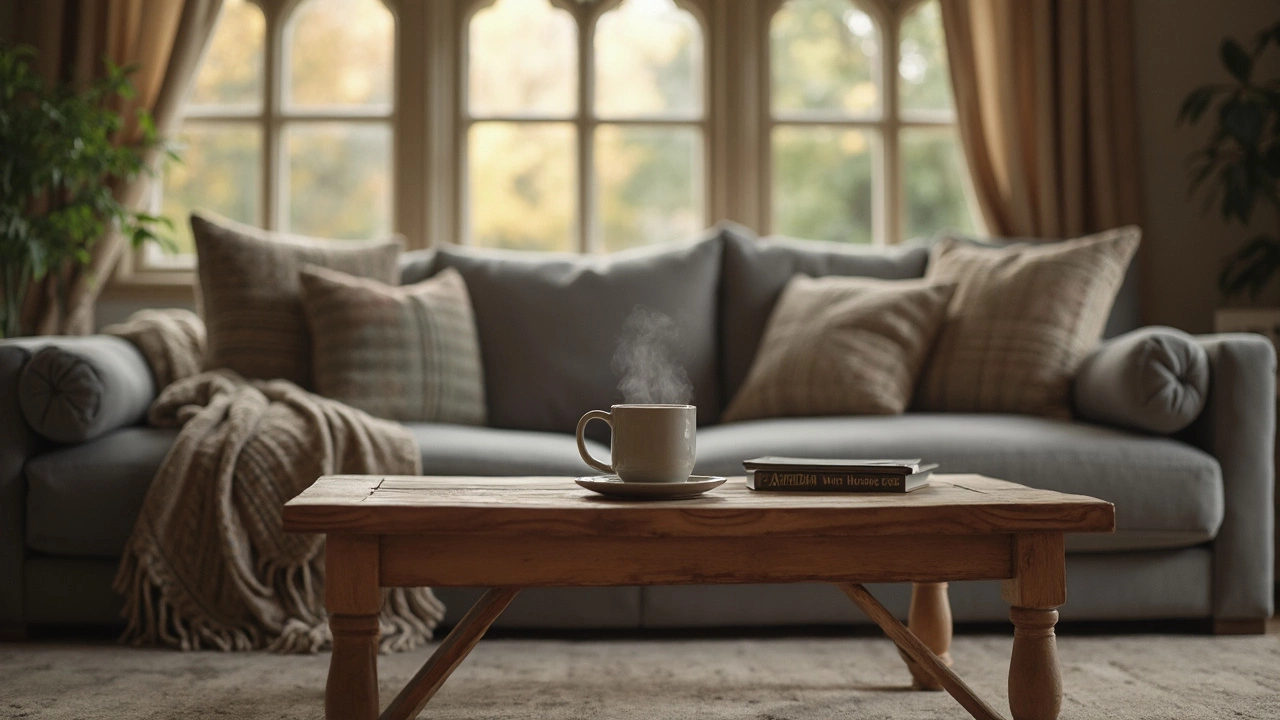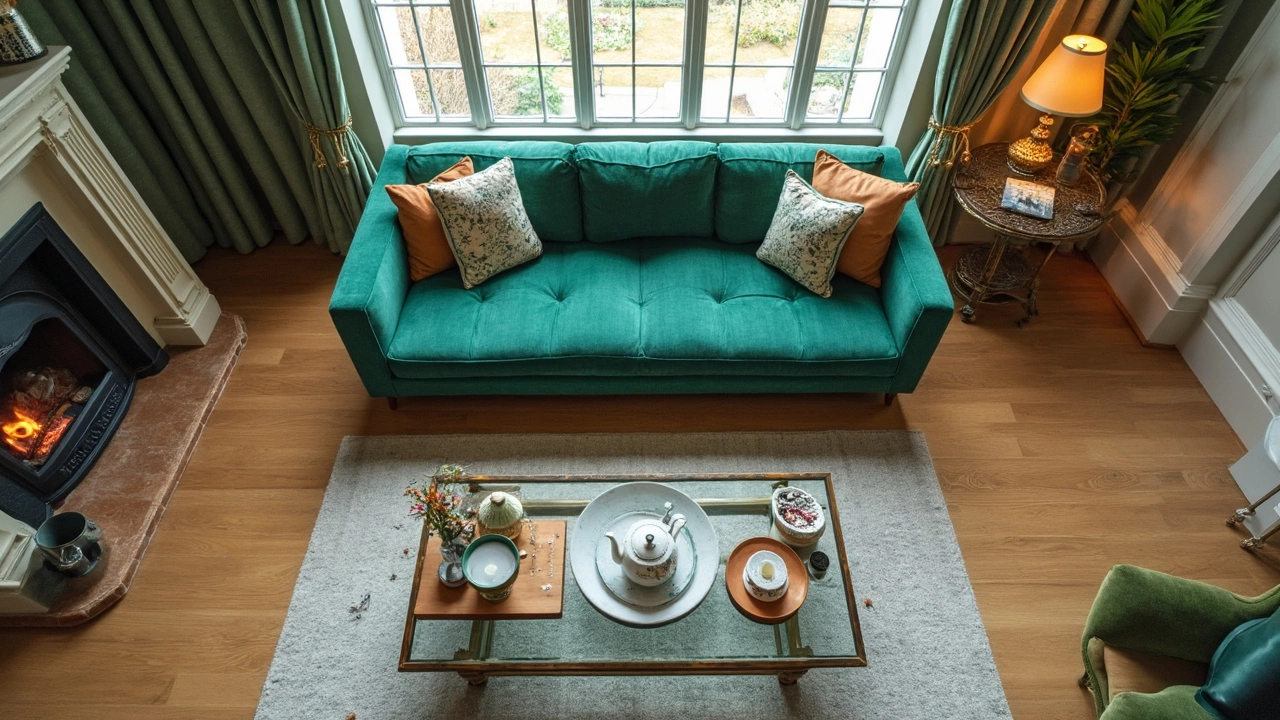
Alright, so you're trying to figure out how far your coffee table should be from the couch. This might seem trivial, but getting the spacing right can make all the difference in your living room's vibe. Generally speaking, aim for about 12 to 18 inches of space. Why does this matter? Well, it's all about comfort and ease of use. You want enough room to move around but still be able to reach your coffee cup or remote without breaking a sweat.
Beyond ease of access, this distance also impacts the room's flow. Too close, and it feels cramped; too far, and you’ll constantly be leaning forward. It's all about striking that perfect balance. Now, if you're working with a smaller space, don't stress—you might need to adjust a bit. But remember, the goal is to keep things comfortable for everyone.
When setting up your living room, figuring out the perfect distance between your coffee table and couch is key to both style and practicality. A general rule of thumb is to keep a gap of 12 to 18 inches between the two.
Why exactly this range? Think of it as a Goldilocks zone. If the table's too close, you'll feel cramped, and no one wants to dodge corners every time they get up. Too far away, and reaching for the remote or that juicy mystery novel takes way too much effort.
Comfort is everything in a living room. That 12 to 18-inch sweet spot is based on the average arm's reach from a seated position. It allows people of varying heights to comfortably grab items off the table without leaning too much.
Beyond function, aesthetics come into play too. A properly spaced table contributes to the visual balance in your space, maintaining proportionate elements that make the room feel welcoming and coherent.
If you’ve got a smaller living room, you might have to tweak things a bit. Opt for a smaller coffee table or go for one with a dual function like built-in storage. You might still aim for the 12-inch distance, but consider moving toward the shorter end of the range to keep the area usable and inviting.
Getting the living room spacing down can seem like a small detail, but trust me, it makes a world of difference in day-to-day usability and overall atmosphere. If it helps, grab a measuring tape and experiment—sometimes a hands-on approach reveals the best setup for your unique space.
So you're wondering why the distance between your coffee table and the couch is such a big deal. Well, it plays a crucial role in your living room's overall aesthetics and functionality. Get it right, and you create a harmonious space where everything feels just right. Get it wrong, and you'll find yourself either squished or awkwardly stretching every time you want something off the table.
The sweet spot of 12 to 18 inches isn't just some number pulled from thin air. It's a practical distance that allows you to reach your coffee table comfortably without slouching or straining. This distance ensures you don’t knock your knees every time you get off the couch. It's all about ease and preventing unnecessary acrobatics in your daily life.
Beyond personal comfort, proper spacing affects room dynamics. A crowded setup feels claustrophobic, making your living room less inviting and more like a game of living room Tetris. Meanwhile, too much space can make you feel like you're playing a game of fetch just to grab the remote.
If you're dealing with a compact area, consider multi-functional furnishings like a nesting table to save room without sacrificing usability. Stylish design doesn't have to give way to practical needs when you plan smartly.
Believe it or not, getting the spacing right is also about safety. Trips and falls in the living room often stem from poorly laid-out furniture. Keeping that ideal distance minimizes such risks, creating a safer zone for you and your family, especially if you have kids running around or older adults visiting.

So, you've got a cozy living room, and you're worried about fitting everything in without feeling packed like sardines. No worries, we've got some tips for making the most of your space while maintaining a comfy style.
If you can't quite manage the ideal 12 to 18-inch gap due to a smaller area, consider working with whatever room you've got. This means a tighter fit, but it's possible to make it functional and comfy.
One idea is to go on the lower end of this range, maybe around 10 inches, if necessary. Just ensure everyone can still reach their drinks or snacks without hassle.
Size matters, especially when selecting a coffee table that complements a small living room. Opt for a smaller, more compact table that can fit comfortably with your layout. Even better, consider choices with storage options underneath to save on space.
In tiny living areas, furniture that does double duty is a lifesaver. Many coffee tables come with lift-tops providing hidden storage or extra surface area. Plus, look for tables with open shelves or nestled stools that can double as seating or tuck away as needed.
Sometimes it’s all about creating the illusion of more space. Opt for a glass top coffee table. The transparency keeps the room feeling airy and open rather than cluttered and boxed in.
| Average Dimensions | Suggestion for Small Spaces |
|---|---|
| Height | 16-18 inches |
| Width | 28-36 inches |
| Depth | 16-24 inches |
Don't stress too much about sticking to rules. Sometimes pushing the coffee table slightly off-centered or even on an angle can free up pathways. Trust your eye to what feels right and also keeps your room looking connected.
It's all about finding the right balance while ensuring your space remains functional and true to your style.
Thinking outside the box with your living room setup can totally change the atmosphere. When it comes to the position of your coffee table relative to the couch, you've got more options than just sticking to the traditional layout.
Combining different design styles keeps your space fresh and interesting. Try pairing a modern glass coffee table with a vintage couch. Not only does it add character, but you can also introduce elements that complement each other thematically.
If you have an open-plan living area, placing your coffee table and couch away from walls gives a laid-back, airy feel. It essentially 'floats' these pieces in the center of the room, creating defined living zones. But remember, keep the table about 12 to 18 inches away from the couch to maintain practicality.
A well-known interior designer, Nate Berkus, once said, "Your home should tell the story of who you are, and be a collection of what you love."
Think beyond the rectangle. Oval or round tables can soften the room's look and are ideal for smaller spaces where corners might get in the way. They also provide a cool contrast to the linear structure of the couch.
In tighter areas, using a coffee table with storage capabilities can be a game changer. Consider tables with shelves or drawers, letting you keep the surface clutter-free.
Don't forget the power of decoration. A stunning centerpiece on the coffee table or some cozy throws on the couch add eye appeal and warmth. Just be sure they don't disrupt the functionality of your living space.
All these ideas aim to create a balance between aesthetics and functionality in your home. It’s about making sure your living room is as comfy as it looks.
Write a comment